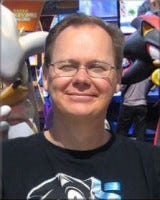How I got into Gaming, Part 3 - Let the Games Begin
How I got into Gaming, Part 3 - Let the Games Began

Virgin Games – Let the Games Begin
The first day on the job, especially your dream job can be so exciting, totally full of expectations and I was fit to explode when I drove into the parking lot at Virgin Games that October morning.
I arrived to find that Virgin Games development group was fairly small at the time with only 3 games in development in-house that I can recall.
There was Overlord which was being developed by Mark Kelly (Programmer) and Steve Crow (Lead Artist), Monopoly which was being developed by John Alvarado (Lead Programmer) and Cool Spot, which was still in its kick-off phase. That was being designed by me the (Designer) with the art initially being developed by Rene Boutin. Our lead programmer, David Perry hadn’t arrived in the states yet when I stated work. David Bishop who was to be my boss also hadn’t arrived yet.
The studio itself was split between upstairs which was marketing and downstairs which was R&D, so it was fairly easy for a newcomer like me to find my way around and get to know everyone by name.
But to be honest knowing everyone and being welcomed by everyone was two different issues.
Yes it’s true, I was finally working as a video game developer, but I had no idea how ground-breaking my roll was at the time, for I found myself in the middle of a culture where the idea if a Game Designer was totally alien and in my case initially totally rejected.
You see, up until that time the Lead Artist and or Lead Programmer on a project was the game designer of a game, so the idea of someone coming in and telling them what to do wasn’t going to fly. It also didn’t help that in their eyes I hadn’t paid my dues by working in console game development before.
So it was a rough few months for me, but with the Director of Development, Stephen Clarke-Willson’s support and the Lead Artist at the time Rene Boutin it kept me going while I tried to prove my worth to others in the studio.
My big break would come when Cool Spot was put on hold and I was reassigned to a game called Global Gladiators, a licensed game for McDonalds. I was asked to come up with an initial level design for the game and present it to the team by the following Monday.
So over the weekend I came up with my first and in full color level design for Global Gladiators and came into the office to present it to the team.
I wasn’t sure how they would respond to my work, for I really wasn’t sure what they would be expecting. But it was done to the best of my abilities at the time and I rolled this really long level design out and held my breath. You could just feel the energy in the room change quickly from skepticism to excitement in a flash. In one day I went from the outsider to the guy people wanted to work with or come to with ideas to flush out, it was a great feeling.
Now, although they liked my work I still had some refining to do on my level design process, for example one of the things I was doing was creating my level designs in full color. This was great for generating an emotional excitement around my level designs, but my boss David Bishop pointed out that it really wasn’t needed and a waste of time. So in future products my level designs went to just black and white drawings. I also had a habit of getting carried away and designing monster size levels, so that to I would scale back over time.
Our first game, Global Gladiators would go on to be a fairly straight forward project for our team, taking about 6.5 months to develop and going on the become Sega’s 3rd Party Game of the Year.
The only hiccup came once the game was done and it was submitted up the chain of command at McDonalds. Unbeknown to us during development, McDonalds owned one of the largest lumbering companies in the United States and having an anti-foresting world in our game really ticked them off, to the point of asking for it to be removed. Something we couldn’t do, for it would have gutted 1/4 of our total game, besides we already had publishing approval in-hand from Sega.
Next our team would go on to develop Cool Spot, which really started to set our teams reputation in the industry for speed of development and quality, when we finished the development in 4.5 months.
Jungle Book would be our team�’s next project, but its development was shipped out to another developer once Virgin Games received the contract to do Aladdin and our team was reassigned to that production.
Aladdin would prove to be our teams crowning achievement, being developed in only 3.5 months and going on to become Game of the Year. It also went on to sell more than 4 million units on a single platform.
Unfortunately Aladdin would also prove to be the end of Virgin Games Golden Age of video game development.
My industry friends have often heard me say that making a hit game can be just as bad as making a terrible one. That is because fame can change people and more often than not, not for the better, and there was no exception when it came to our team, now called the “Global Team”.
Once the press rolled in the egos came out and getting your face in a magazine became a really high priority for some in the company. This started to create a lot of tension within the company and within the different teams, leading eventually to the end of Virgin Games Golden Age and the end of the Global Team.
My own decision to leave Virgin Games came shortly after most of my team left to form Shiny Entertainment, founded by David Perry our teams Lead Programmer.
By that time I was the Senior Game Designer for the studio and teacher to many up and coming designers within the company and I was moving more and more into more of a manager roll than that of lead designer, which was what I really wanted to continue doing.
So when an offer came in from Spectrum Holobyte to be a design manager for their studio in the Bay Area I jumped at the opportunity.
Oh boy was that a bonehead move, but that’s the next chapter of my life :-)
Read more about:
BlogsAbout the Author(s)
You May Also Like













